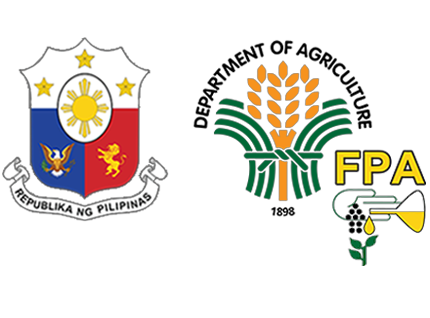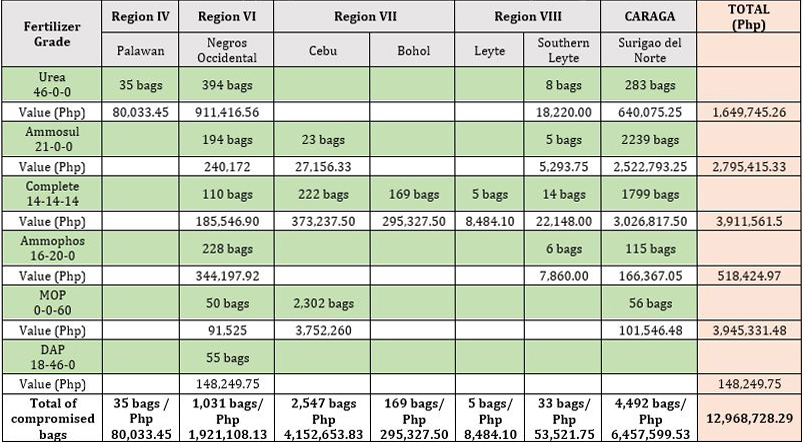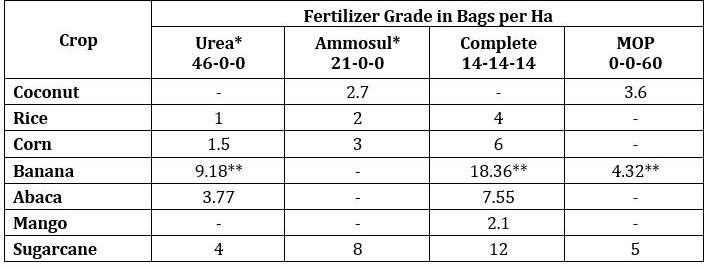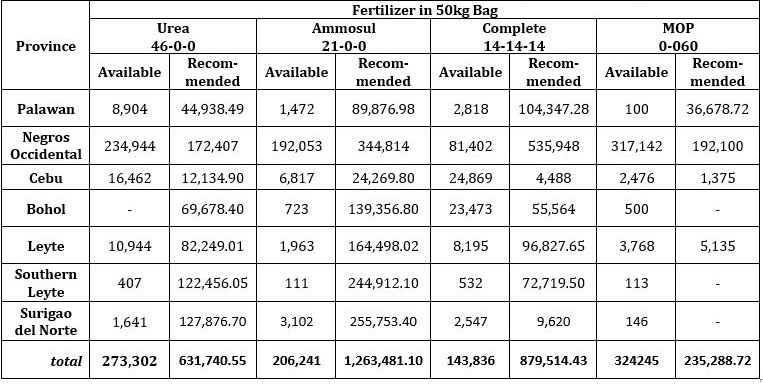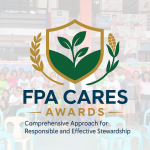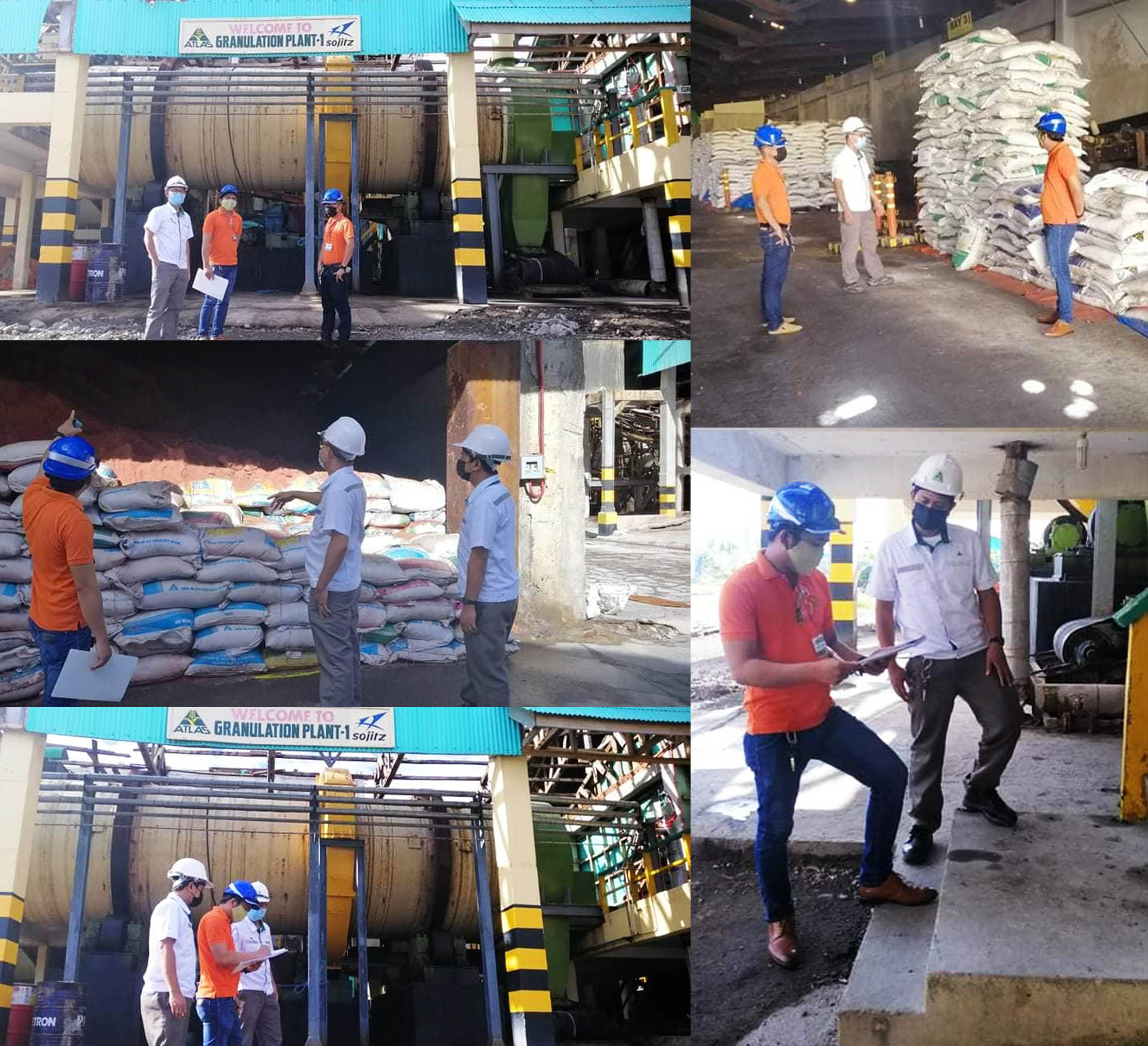
QUEZON CITY, January 31, 2022 – Typhoon Odette (Rai) hit the Philippines on December 16, 2021, leaving agricultural damage and losses at Php 13.3 billion and affecting more than 500,000 farmers and fishers in Surigao del Norte and Dinagat Islands in Mindanao, five provinces in the Visayas, and the island of Palawan in Luzon.
Nine fertilizer handlers were affected after their FPA-licensed warehouses containing bulk stocks for distribution did not escape the blow of Odette. A total of 8,312 bags of fertilizers in different grades were among the assets damaged by the typhoon, accounting for around 415,600 kilograms of quality compromised fertilizer stocks in said provinces.
Handlers such as the Cardinal Farm Supply accounted for 4,492 bags in Surigao del Norte, while the Atlas Fertilizer Company accounted for 2,547 bags in Cebu and the Falcor Marketing Corporation 1,031 bags in Negros Occidental. Table 1 shows the distribution of quality-compromised fertilizer supplies per region affected by the typhoon.
Estimated Value of Affected Fertilizers
Based on the price monitoring conducted by the Provincial Officers of FPA from December 14–18, 2021, the estimated value of compromised fertilizers is Php 12.96 million. The provinces of Surigao del Norte, Cebu City, and Negros Occidental constituted 97% of the total value with Php 6.45 million, Php 4.15 million, and Php 1.92 million, respectively.
The value of compromised fertilizer stocks reached over a million, such as Ammonium Sulphate (21-0-0), Complete (14-14-14), Muriate of Potash (0-0-60), and Urea (46-0-0) (Table 1). They are valued respectively at Php 2.79 million, Php 3.91 million, Php 3.94 million, and Php 1.64 million. Despite the recorded damages, prices of fertilizers will not be affected, and the importation prices will still dictate their prices.
Table 1. Estimated Value of Six (6) Major Grades of Fertilizer Affected per Region
Crop Estimated Fertilizer Recommendations
The fertilizer recommendations are referenced from the Philippines Recommends Soil Fertility Management (2006). The data for the actual area affected by the typhoon came from the Department of Agriculture – Disaster Risk Reduction and Management Service (DA – DRRMS).
Table 2 shows the fertilizer recommendations for the crops planted in the affected areas. Additionally, Philippine National Standards are referenced for the computation of planting distance for specific crops.
Table 2. Estimated Fertilizer Recommendations of Selected Crops per Hectare
*Urea and Ammosul may be used interchangeably depending on their availability
**Requires two to four applications per year
Affected Provinces
Palawan
The total area affected in the Province of Palawan is 12,542 ha. 59.07% of which is planted with Rice (7,409 ha), 31.08% is planted with Banana (3,898 ha), while 5.67% is planted with Coconut (711 ha), and 4.18% is planted with Corn (524 ha). Table 3 shows the estimated amount of fertilizers to be used per crop.
Table 3. Fertilizer Recommendations for the Area Affected in Province of Palawan
Surigao del Norte
The total area affected in the Province of Surigao del Norte is 96,252 ha. 96.56% of which is planted with Coconut (92,942 ha), 2.5% is planted with Rice (2,405 ha), and 0.94% is planted with other crops (905 ha). Table 4 shows the estimated amount of fertilizers to be used per crop.
Table 4. Fertilizer Recommendations for the Province of Surigao del Norte
Negros Occidental
The total area affected in the Province of Negros Occidental is 58,767 ha. 65.38% of which is planted with Sugarcane (38,420), 31.87% is planted with Rice (18,727 ha), while 2.75% is planted with other crops (1620 ha). Table 5 shows the estimated amount of fertilizers to be used per crop.
Table 5. Fertilizer Recommendations for the Province of Negros Occidental
Southern Leyte
The total area affected in the Province of Southern Leyte is 78,456 ha. 83.93% of which is planted with Coconut (65,849 ha), 10.41% is planted with Abaca (8,170 ha), 3.52% is planted with Rice (2,759 ha), while 2.14% is planted with other crops (1,678 ha). Table 6 shows the estimated amount of fertilizers to be used per crop.
Table 6. Fertilizer Recommendations for the Province of Southern Leyte
Leyte
The total area affected in the Province of Leyte is 49,915 ha. 66.11% of which is planted with Coconut (32,998 ha), 17.28% is planted with Rice (8,625 ha), 13.27% is planted with Abaca (6,623 ha), 2.06% is planted with Sugarcane (1,027 ha), while 1.28% is planted with other crops (642 ha). Table 7 shows the estimated amount of fertilizers to be used per crop.
Table 7. Fertilizer Recommendations for the Province of Leyte
Cebu
The total area affected in the Province of Cebu is 8,526 ha. 93.29% of which is planted with Coconut (7,954 ha), 3.48% is planted with Rice (297 ha), and 3.23% is planted with Sugarcane (275 ha). Table 8 shows the estimated amount of fertilizers to be used per crop.
Table 8. Fertilizer Recommendations for the Province of Cebu
Bohol
The total area planted in the Province of Bohol is 55,215 ha. 74.84% of which is planted with Coconut (41,324 ha), while 25.16% is planted with Rice (13,891 ha). Table 9 shows the estimated amount of fertilizers to be used per crop.
Table 9. Fertilizer Recommendations for the Province of Bohol
Current Inventory Stocks and Requirement
Based on the current fertilizer stock inventory of January 24-28, 2022, all affected provinces have insufficient fertilizer to supply the estimated recommendation except for the Urea and Muriate of Potash (MOP) in Negros Occidental . The total recommended fertilizers needed to all affected provinces is 3,010,024.80 bags. Table 10 summarizes the available fertilizer and the estimated recommendation.
Table 10. Available and Estimated Recommendation of Fertilizer per Affected Regions
To mitigate the problem, alternative sources of fertilization should be used. For Coconut, green manure like ipil-ipil and farm organic wastes such as manure of cattle, carabao, pig, goat, chicken, compost, and night soil can be used to replace part of the commercial fertilizer requirements. Coconut crown residues as organic fertilizer and nitrogen-fixing legumes can substitute for Ammonium Sulphate as N-sources while cocopeat and husk for chlorine.
Actions from the FPA
The FPA, through its Regional Field Units (RFUs), coordinated with the affected fertilizer handlers. The handlers were informed about the process of the Fertilizer Regulations Division on disposing of unsound fertilizers.
Damaged fertilizers due to the typhoon may be categorized as such and may still be sold to registered cooperatives at a discounted price. However, the analysis should still be done to confirm the actual content of the damaged fertilizers. Optimal fertilizer recommendations should be based on the soil and tissue analyses before application.
Sources:
Department of Agriculture – Disaster Risk Reduction Management Bulletin #30 on Typhoon Odette
Philippine Coconut Authority Techno Guide on Fertilization No. 01/2019
Philippine National Standards Good Agricultural Practices on Abaca, Banana, Coconut, and Mango
Department of Science and Technology – Philippine Council for Agriculture, Forestry and Natural Resources Research and Development. Philippine Recommends Soil Fertility Management 2006
Written by: Edward Allen A. Calapatia, Jan Paolo E. Umerez | Published: 7 February 2022
Fertilizer and Pesticide Authority (FPA) Online ISSN: 2815-1674
Published by the FPA Information and Communications Team
